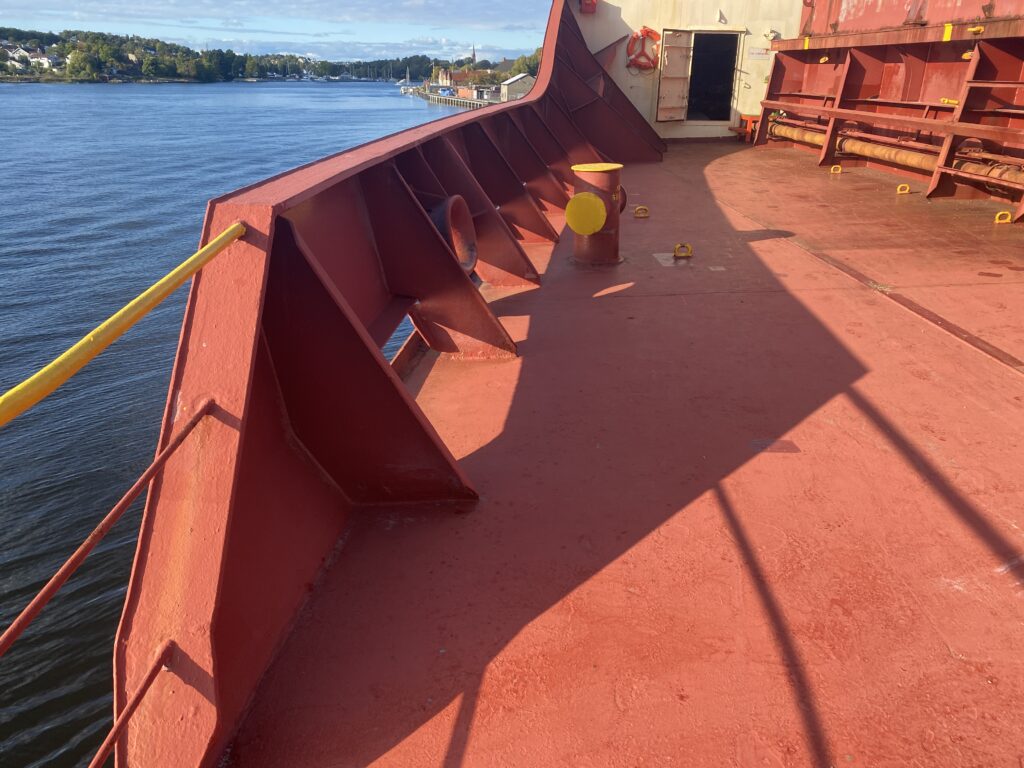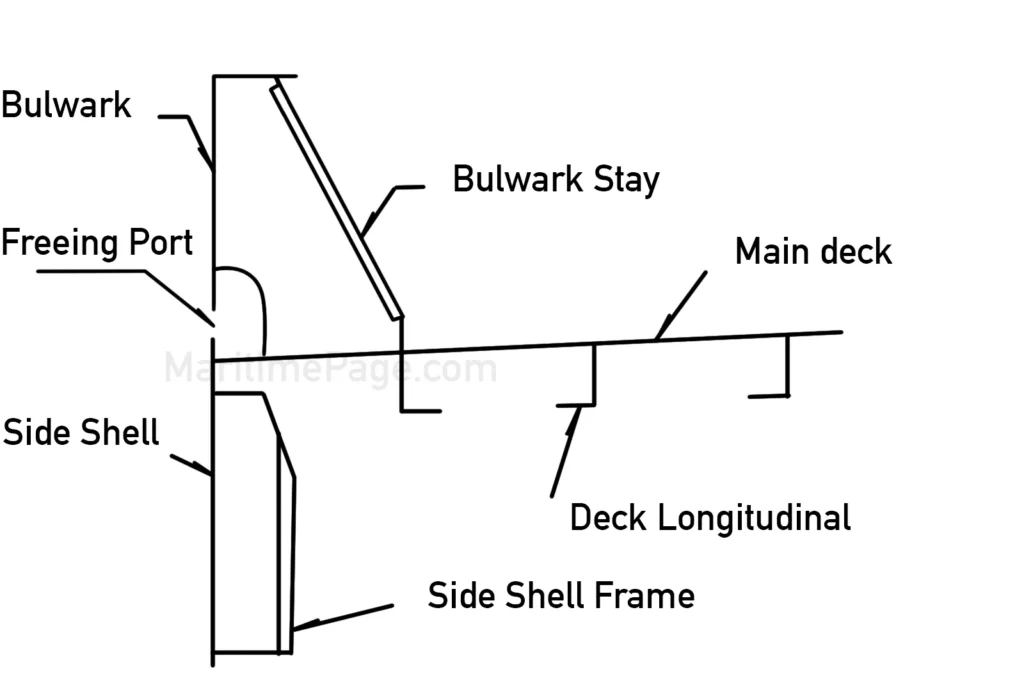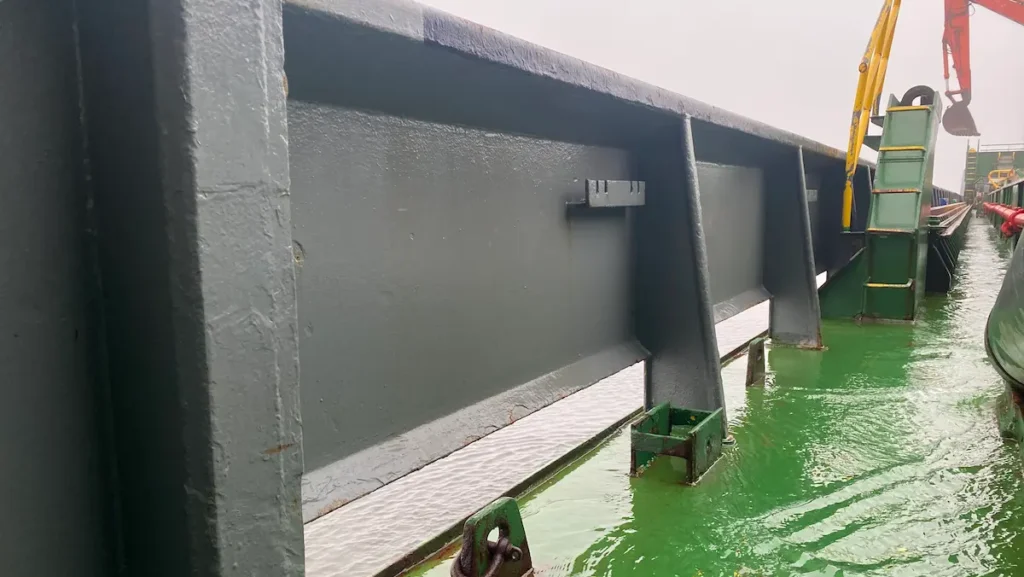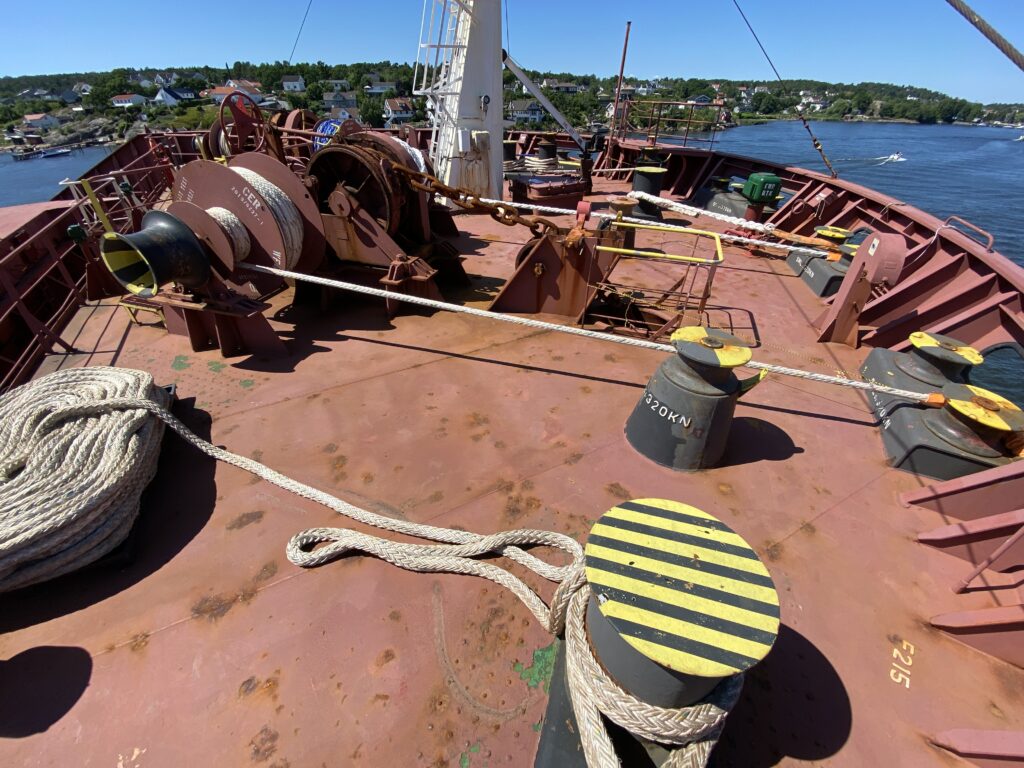What Defines a Bulwark on a Ship?
Bulwarks can be defined as the extension of side shell plating above the level of the weather deck which serves as a solid, providing safety to passengers and crew on board to prevent them from falling off the vessel.
Bulwarks in ships don’t play a major role in providing structural integrity and hence the plating used for them is considerably less thick than the other structural plates.

How Are Bulwarks Constructed?
Bulwarks are designed as per minimum requirements from those mentioned as from classification societies in terms of their minimum height and plate thickness requirements.
In open areas the height is specified to be a minimum of 1 meter as per IMO rules only in exceptions can it be less than 1m if it affects the ship’s operability. The bulwarks are normally supported by stanchions.

Special openings called freeing ports can be found on bulwarks on the level with the weather deck through which green water or water accumulated due to weather conditions can freely run off the vessel’s deck to the outside.
Structurally the bulwarks are normally supported by rail sections and stay that connect to the main deck. The spacing of these stays is normally calculated by an empirical formula given by the class society rules which are related to the ship length which is 0.93*L R not more than 1.2m apart.

In places of openings such as freeing ports, the edges are stiffened, and also in areas where mooring lines pass through the thickness is normally doubled or the necessary amount of stiffening is provided.
Also, it should be noted that the bulwarks should not be cut for any purposes at the breaks of the superstructure such that there won’t is any structural weak points to ensure efficient load transfer.

What are the Advantages And Disadvantages of Bulwark?
Bulwarks on ships serve as crucial safety barriers, but they also come with their own set of challenges.
Let’s take a look into the advantages, such as providing safety and aiding in work activities, and the disadvantages, including operational obstructions and maintenance demands, to offer a balanced view of their impact on maritime operations.
Advantages of Bulwarks
- Safety and Protection: The primary function of bulwarks is to provide safety for passengers and crew. They act as a barrier, preventing individuals from accidentally falling overboard, which is crucial especially in rough sea conditions.
- Support for Work Activities: For professions like fishing, bulwarks offer essential support. Fishermen, for example, can lean against them for stability while casting nets or reeling in fish. This ergonomic feature aids in reducing physical strain during such activities.
- Structural Integration for Deck Equipment: Bulwarks are often designed to accommodate various deck fittings like cleats, which are used for securing ropes. The integration of such equipment into the bulwark structure enhances deck functionality and efficiency.
- Water Management: The inclusion of scrappers or freeing ports in bulwarks is vital for efficient water management on the deck. These openings allow seawater that washes onto the deck, often in rough weather, to drain away quickly, thereby reducing the risk of flooding and maintaining stability.
Disadvantages of Bulwarks
- Potential Obstruction in Operations: In certain vessel designs, especially workboats, bulwarks may pose an obstruction. They can interfere with the loading and unloading of cargo, the operation of deck machinery, or even impede the crew’s movement in performing specific tasks.
- Structural Limitations: The thinner plating of bulwarks, compared to other structural parts of the ship, means they are less capable of handling high loads. This limitation is significant in the context of point or pin loads, where the bulwark may not withstand excessive forces, leading to potential structural compromise.
- Maintenance and Inspection Challenges: Bulwarks, especially those with integrated equipment and openings, may require more rigorous and frequent inspections. Corrosion, wear and tear around fittings, and the integrity of freeing ports are critical areas that need regular checks to ensure safety.
- Weight and Balance Considerations: While providing safety and functionality, bulwarks add extra weight to the ship. In ship design and operation, the weight and placement of bulwarks need careful consideration to maintain the vessel’s balance and stability.
Why Are Bulwarks Vital for Maritime Safety?
Bulwarks are a critical component of maritime safety. They provide a physical barrier that prevents crew and passengers from falling overboard, significantly reducing the risk of maritime accidents.
In harsh sea conditions, they offer additional protection against high waves and strong winds. By integrating safety features like railings and freeing ports, bulwarks also contribute to the overall seaworthiness of a vessel, ensuring that it remains safe and stable even in adverse weather conditions.
What Varieties of Bulwarks Exist?
There are various types of bulwarks, often distinguished by their design, material, and the specific type of vessel they are used on. Common variations include:
- Solid Bulwarks: Typically seen on larger vessels, made from robust materials like steel or aluminum.
- Open Bulwarks: Often found on smaller boats, with openings or railings for visibility and ventilation.
- Hybrid Bulwarks: A combination of solid and open elements, offering both protection and visibility.
Each type is designed to meet the unique needs of different ship designs and their operational environments.
How Have Bulwarks Evolved Over Time?
Historically, bulwarks were simpler structures, primarily serving as basic protective barriers. Over time, with advancements in shipbuilding technology and increased focus on safety, modern bulwarks have evolved to become more sophisticated. They now incorporate features like freeing ports for water drainage, integrated equipment fittings, and are made from more durable and lightweight materials. This evolution reflects the maritime industry’s commitment to safety, efficiency, and technological innovation.
What Are the Challenges in Bulwark Maintenance?
Maintaining bulwarks presents several challenges:
- Corrosion and Wear: Being exposed to harsh marine environments, bulwarks are susceptible to corrosion, requiring regular maintenance and anti-corrosive treatments.
- Inspection of Freeing Ports: Ensuring that freeing ports are not blocked and function correctly is crucial for deck safety.
- Structural Integrity Checks: Regular inspections are needed to detect any structural weaknesses or damages, especially in areas where equipment is integrated.
Effective maintenance is vital to ensure the long-term functionality and safety of bulwarks.
Where Else Are Bulwarks Used Besides Ships?
Beyond ships, the concept of bulwarks is applied in other areas:
- Coastal and Riverine Structures: Bulwarks are used in embankments, sea walls, and riverbanks for protection against water and erosion.
- Architecture and Construction: Some buildings incorporate bulwark-like features for safety in high-rise structures or balconies.
How Do Bulwarks Impact Ship Design and Aesthetics?
Bulwarks significantly influence both the practical design and aesthetic appeal of a ship. They must be integrated seamlessly into the overall design, maintaining the vessel’s structural integrity and balance. Aesthetically, bulwarks contribute to the ship’s silhouette and profile. Designers often balance functionality with visual appeal, ensuring that bulwarks complement the overall style and lines of the vessel.
Adding these sections will provide a comprehensive and detailed understanding of bulwarks in maritime contexts, enriching your article and engaging your readers with a broad spectrum of information on the topic.
Summary and Video to Watch
Bulwarks can be found throughout the vessel’s exterior boundary which plays a major role in terms of safety for passengers and crew on board and is mandatory for all vessels both commercial and non-commercial.
- Types of Gas Carriers as per IGC Code – April 22, 2025
- Wind-Assisted Propulsion Systems (WAPS): A Game Changer for Maritime Decarbonization – February 6, 2025
- 10 Boat Salvage Yards in California – January 25, 2025




